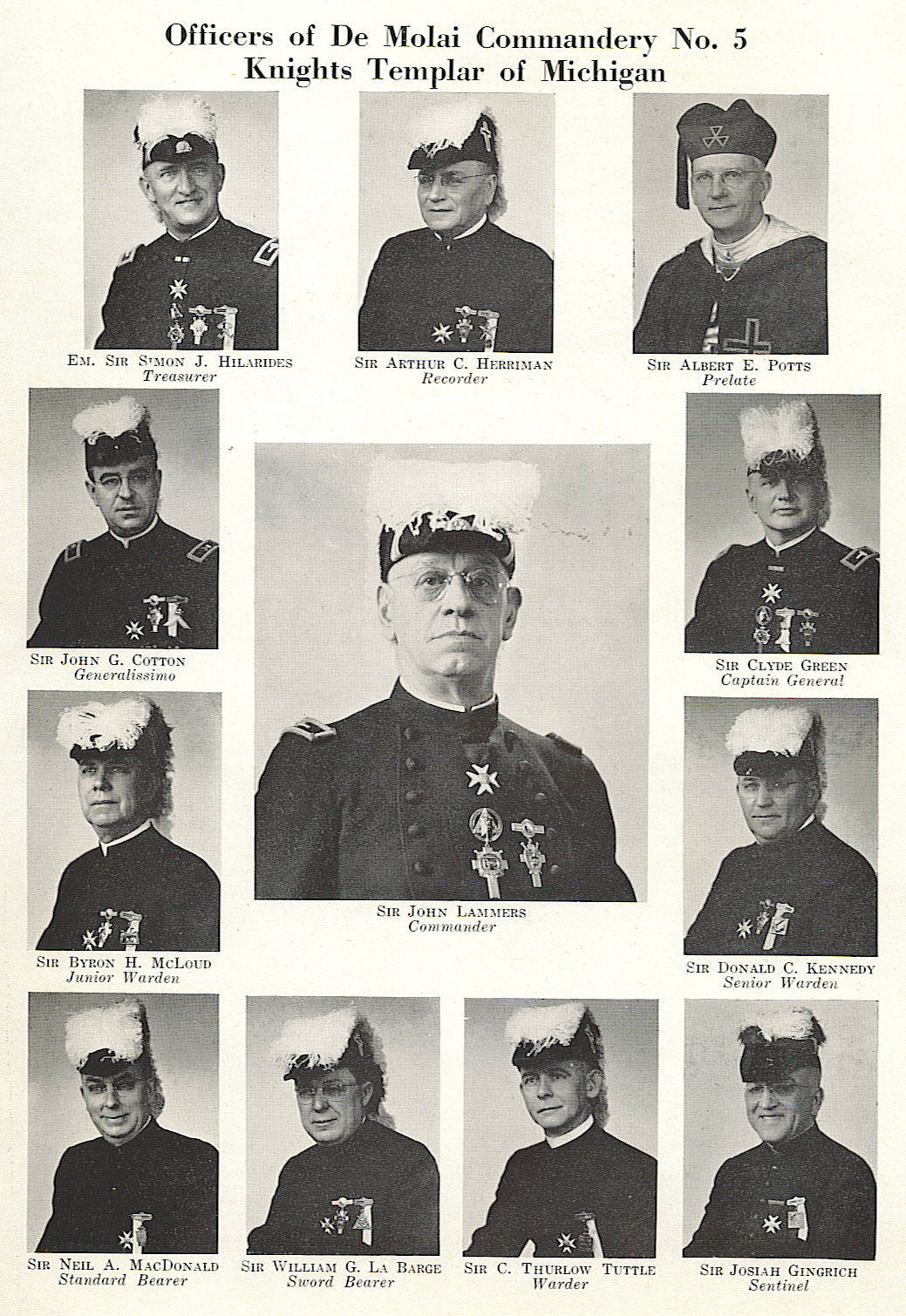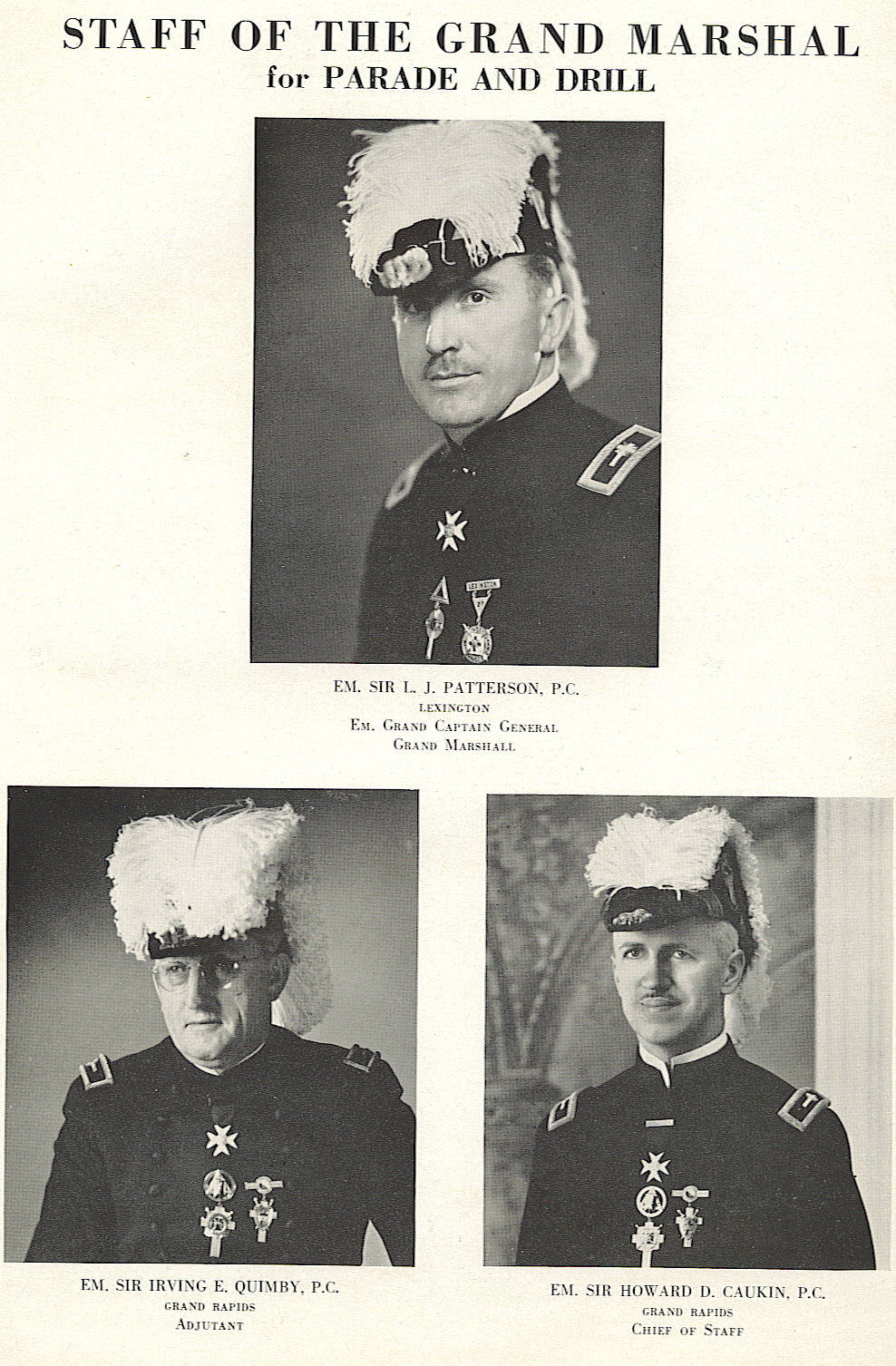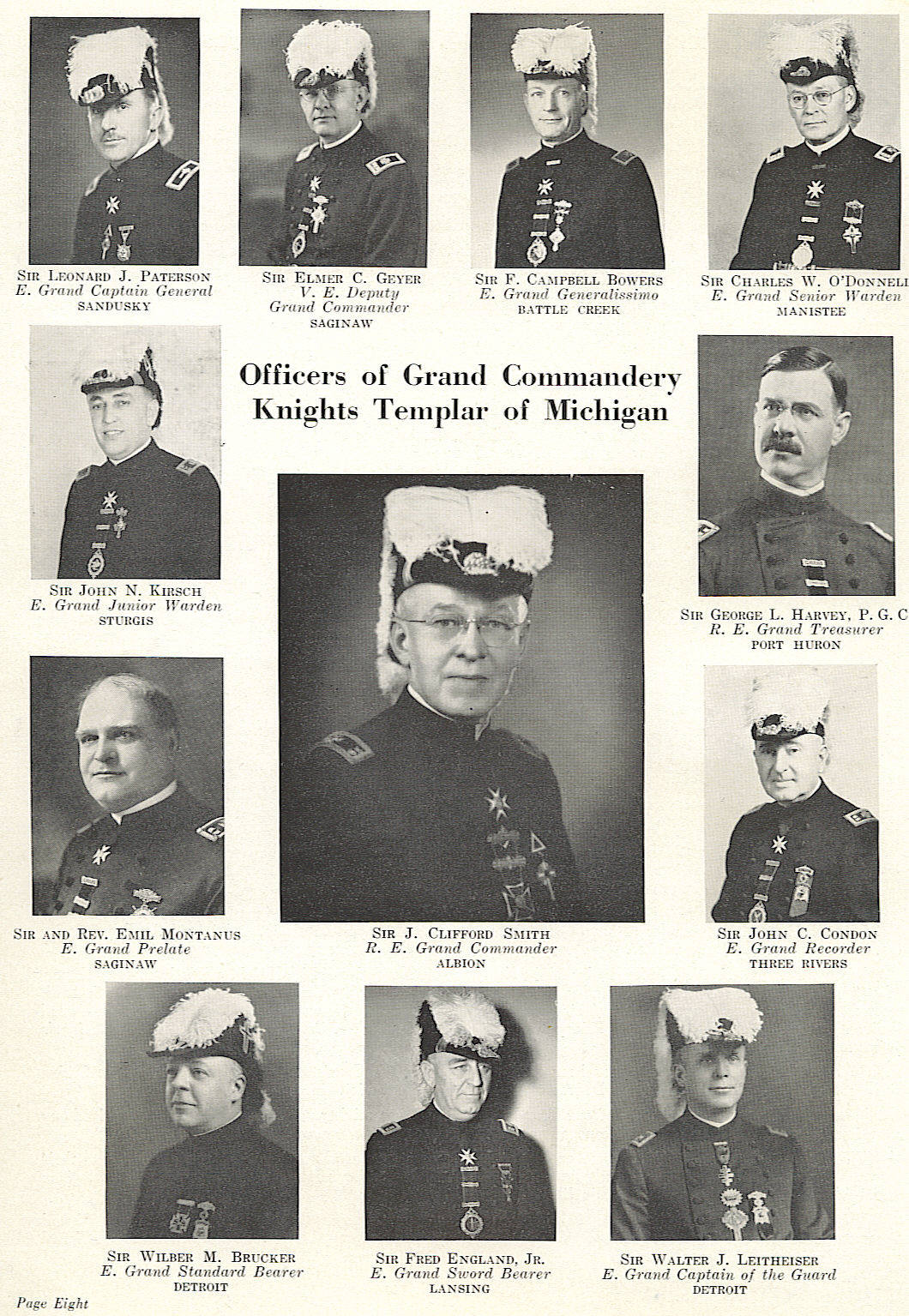
De Molai Commandery, No. 5, K.T.
1856 – 1946

1946 Commanders of De Molai Commandery No. 5

1946 Grand Marshall Parade Participants

|
Officers of the Grand Rapids Commandery No. 5, 1946 (This information is from a book owned by Nancy Myers, The 90th Conclave of the Michigan Knights Templar, Grand Commandery, De Molai Commandery No. 5, held at Grand Rapids, Michigan on June 3, 4, and 5, 1946.) History of De Molai Commandery, No. 5, K.T. De Molai Commandery No. 5, K.T., is celebrating its Ninetieth Anniversary this year, 1946, A.D., and A.O. 828 and no greater honor could be conferred upon De Molai than the privilege of entertaining the Grand Commandery Knights Templar of Michigan at their Ninetieth Grand Conclave now being held in Grand Rapids. De Molai Commandery No. 5, K.T., was organized at Grand Rapids, July 23, 1856, under a dispensation from William B. Hubbard, Grand Master of the Grand Encampment of the United States of America bearing date of May 9, 1856, there were present at the organization seven Sir Knights from Detroit Commandery No. 1, including two clergymen, Rev. F. H. Cuming, P.G.C. and Rev. F. A. Blades. D. S. Leavitt was named in the dispensation as Grand Commanders, William P. Innes as Generalissimo and Fred Hall as Captain General and was designated as De Molai Commandery No. 6. On January 8, 1858, De Molai received invitation to be present at the organization of a State Grand Commandery at Detroit, Michigan, January 11, 1858, and on July 2, 1858, received Charter from the Grand Commandery of Michigan as De Molai Commandery No. 5. Such was the beginning of the host of the 90th Grand Commandery Conclave now being held in Grand Rapids 90 years later and for ten decades its history has been making a record envied by many. De Molai’s Commandery’s growth has been steady, boasting a membership at one time of over a thousand members and now rapidly approaching that mark again, it has practiced the grand characteristics of the Order, having a well established Hospitalers Committee doing a marvelous job, the De Molai Drill Corps with nearly 200 members and the Educational Foundation occupy prominent places in De Molai’s history. On its Membership Rolls are found names of many prominent persons, some having reached the highest honors their Commandery can bestow, namely, Eminent Commander; others have been rewarded with the leadership of the Grand Commandery with the title of Right Eminent Grand Commander and still another has been elevated to the highest office in Templarism, that of Grand Master of the Grand Encampment of the United States. Among the members who have honored the Grand Commandery with their leadership are the following serving as Grand Commanders: 1860 – William Power Innes 1863 – Luman Russell Atwater 1867 – Edward D. Benedict 1874 – Leonard Haskell Randall 1884 – Heman Nickerson Moore 1904 – Richard D. Swartout 1917 – Mark Norris 1924 – H. Bruce Norris 1937 – Fred H. Locke De Molai has been honored in the past by having one of its members an Eminent Commander, a Right Eminent Grand Commander and the Grand Master of the Grand Encampment of the United States, we speak with great pride of the late Mark Norris who has occupied these honored positions. For ninety years the name of De Molai has been synonym for high morals and character; it has taken the lead in fraternal affairs, it has sponsored movements for the protection of the afflicted, it has done much to alleviate suffering. It has been the host of the Grand Commandery on several previous occasions and is always happy and willing to entertain, for hospitality is on of its chief characteristics. De Molai appreciates the honor of being your host again in 1946 and (hopes) that your visit will be a most pleasant one with memories that will remain for years to come. Sir Arthur C. Herriman, Recorder The Order’s History Here and Abroad Throughout its 239-year history Freemasonry found that its secrecy and rituals have both attracted members and aroused enemies. When cathedral-building in England decreased in the mid-17th Century, many guilds of stoneworkers, known as free masons apparently because they were free to move from town to town, became purely social groups. They often initiated non-masons as members, calling them speculative Masons. In 1717 four London Lodges composed largely of speculative Masons formed the Grand Lodge of England. After decades of religious bitterness many Englishmen now found comfort in a moral system based on unchanging building tools – the compass, square and level – and embraced an order that saw God as "the Grand Architect". Wherever Englishmen went they founded Masonic Lodges, Enlightened Europeans, certain of human perfectibility and distrustful of ancient institutions like the Catholic Church, joined. Among them were Frederick the Great, Voltaire and Mozart. But the strange costumes, the aristocratic flavor of Freemasonry made the lower classes suspicious. In London Masonic parades were stoned. The antagonism to the Roman Catholic Church that grew with the Enlightenment was reflected in anticlerical attitudes of leading Masons. This aroused the hostility of Pope Clement XII who in 1738 denounced the order, "for if they were not acting ill, they would not … have such a hatred of the light." Lodges in Catholic nations were closed, often by mobs. Today, though a few Catholics are Masons, the Church has never reversed its historical position. Any Catholic who takes part in Masonic religious rituals or swears Masonic oaths of secrecy that could run counter to the Catholic concept of the confessional has automatically excommunicated him self. Brought to America by British colonists, Freemasonry, with it emphasis on brotherhood, enlisted many leading colonial Americans who saw in the order a vehicle for establishing the principles of liberty and equality. It grew into a patriotic movement and some historians believe that the "Indians" who took part in the Boston Tea Party were Masons from Boston’s St. Andrew’s Lodge. On the day of a Lodge meetings Masons were observed going into the Green Dragon Tavern, their meeting place. "Indians" were later seen leaving for the wharf. During the Revolutionary War, Washington, who said the order’s goal was "to promote the happiness of the human race," favored creation of military lodges for soldiers. There were at least 11 such lodges, the most famous being American Union Lodge Number One. At Valley Forge, Washington helped initiate Lafayette into Masonry. Washington, Worshipful Master of Alexandria, Va. Lodge, was a zealous Mason for 47 years. Some Masons started a movement to make him national Grand Master of all U. S. Masons, to be untied into a national grand lodge. But Massachusetts Masons did not consent and the idea died. Benjamin Franklin, first Grand Master of Pennsylvania, also joined Paris Lodge when he was ambassador to France, helped to initiate Voltaire into Masonry. Freemasonry’s only U. S. crisis came in 1826 when an ex-Mason, William Morgan, disappeared after publishing his Lodge secrets. Masons were accused of kidnapping Morgan and in the resulting furor an Anti-Mason party was formed. In 1832 the Anti-Masonic party ran a presidential candidate, William Wirt, against Andrew Jackson, a Mason. Wirt carried the state of Vermont but nothing else and soon the Anti-Masonic political party died out. After 1832, Freemasonry began to lose its political tinge, taking on the social and more emphatically fraternal character it has today. This helped its steady growth. There were 200,000 members when the Civil War began in 1861. During the war over a hundred military Lodges were formed. After the Civil War they helped in the order’s period of great growth. By 1900 there were over 800,000 members. |
Succession of Commanders
Of De Molai Commandery No. 5, 1856-1945
|
YEAR |
COMMANDER |
YEAR |
COMMANDER |
| 1856-58 | David S. Leavitt | 1911 | William E. Elliott |
| 1859 | Edward D. Benedict | 1912 | H. Bruce Moore |
| 1860 | John C. Buchanan | 1913 | William M. Clarke |
| 1861 | James W. Sligh | 1914 | Charles I. Buell |
| 1862 | David S. Leavitt | 1915 | William A. Brown |
| 1863 | Luman R. Atwater | 1916 | John L. Retting |
| 1864 | Edward D. Benedict | 1917 | C. Fred Schneider |
| 1865-66 | George Gray | 1918 | George K. Phillips |
| 1867-69 | John W. Champlain | 1919 | Charles E. Converse |
| 1870-72 | Leonard H. Randall | 1920 | John G. Gronberg |
| 1873-75 | Leonard H. Randall | 1921 | William S. Denison |
| 1876 | Charles S. Allen | 1922 | Claude M. Hurd |
| 1877-79 | Heman N. Moore | 1923 | Edwin J. MacMillan |
| 1880-82 | Heman N. Moore | 1924 | Fred H. Locke |
| 1883-84 | George E. Pantlind | 1925 | Hugh E. Musselwhite |
| 1885-86 | Henry F. Hastings | 1926 | Peter T. Hendricks |
| 1887-88 | Samuel E. Watson | 1927 | Harry O. Biggam |
| 1889 | Richard D. Swartout | 1928 | Mark V. Burlingame |
| 1890-92 | Joseph C. Herkner | 1929 | Ransom W. Luce |
| 1893 | George F. Buss | 1930 | Henry W. Walstrom |
| 1894 | Jay D. Utley | 1931 | Irving E. Quimby |
| 1895-96 | Charles M. Heald | 1932 | Arthur W. Hess |
| 1897 | Lucius D. Harris | 1933 | Walter Gatherer |
| 1898 | Fred M. Briggs | 1934 | Richard W. Atwell |
| 1899 | Harry K. Dean | 1935 | Laurence D. Benedict |
| 1900 | Charles E. Fink | 1936 | Howard D. Caukin |
| 1901 | John Rawson | 1937 | Henry W. Lightner |
| 1902 | John H. P. Hughart | 1938 | Eskild V. Berggren |
| 1903 | James G. Robinson | 1939 | Raymond J. Shinn |
| 1904 | William M. Adams | 1940 | Floyd C. Fisher |
| 1905 | Walter H. Booth | 1941 | Marion N. Green |
| 1906 | Charles L. Fitch | 1942 | Barend J. Fisher |
| 1907 | Mark Norris | 1943 | Stanley G. Kucera |
| 1908 | William J. Clark | 1944 | Clyde I. Green |
| 1909 | Harry G. Robertson | 1945 | Simon J. Hilarides |
| 1910 | William E. White | 1946 | John Lammers |
Commanders from the Central West Michigan Area of the
Succession of Grand Commanders of the Grand Commandery
of Michigan Since Organization, April 7, 1857 - 1945
| YEAR | NAME AND COMMANDERY NO. | RESIDENCE | DATE OF DEATH |
| 1860 | William Power Innes (5) | Grand Rapids | 2 Aug 1893 |
| 1863 | Luman Russell Atwater (5) | Grand Rapids | 23 Jul 1892 |
| 1864 | Benjamin Porter (9) | Jackson | 13 Mar 1910 |
| 1867 | Edward D. Benedict (5) | Grand Rapids | 30 Jan 1892 |
| 1870 | John Lewis Mitchell (9) | Jackson | 10 Jul 1904 |
| 1874 | Leonard Haskell Randall (5) | Grand Rapids | 18 Jun 1918 |
| 1878 | Hollis F. Knapp (9) | Jackson | 4 Feb 1897 |
| 1879 | Frank Henderson (8) | Kalamazoo | 3 Jan 1899 |
| 1884 | Heman Nickerson Moore (5) | Grand Rapids | 3 Nov 1896 |
| 1886 | William S. Lawrence (8) | Kalamazoo | 9 May 1910 |
| 1887 | Thomas Hart Williams (9) | Jackson | 24 Apr 1911 |
| 1888 | Charles Pierce Bigelow (23) | Big Rapids | 15 Oct 1916 |
| 1889 | John Archibald Gerow (17) | Marshall | 10 Jan 1914 |
| 1896 | Edward Dodge Wheeler (32) | Manistee | 27 Nov 1906 |
| 1897 | Albert Stiles (9) | Jackson | 6 Mar 1899 |
| 1904 | Richard D. Swartout (5) | Grand Rapids | 1 Aug 1919 |
| 1908 | Hutson Benedict Colman (8) | Kalamazoo | 28 Mar 1917 |
| 1917 | Mark Norris (5) | Grand Rapids | |
| 1918 | Charles Henry Patterson (9) | Jackson | |
| 1919 | Edmond Stuart Rankin (8) | Kalamazoo | 14 Feb 1924 |
| 1924 | Harold Bruce Moore (5) | Grand Rapids | |
| 1931 | Thane Benedict (11) | Ionia | |
| 1935 | John Henry Rademarker (32) | Manistee | |
| 1937 | Fred H. Locke (5) | Grand Rapids | 5 Jan 1945 |
| 1941 | Charles Lenzo Bennett (8) | Kalamazoo |
Transcriber: ES
Created: 8 January 2006